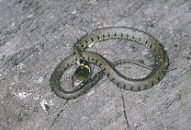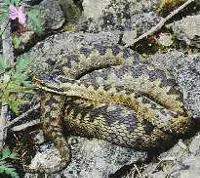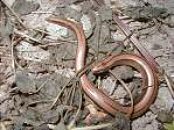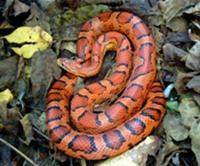Snakes
All snakes in the UK are protected under The Wildlife and Countryside Act 1981 Schedule 5.
It is an offence to kill, injure or take a native snake. Garden snakes are nearly always slow worms, which are actually legless lizards.
Quick Identification is all down to the neck:
- slow worms have no neck - their head and body are all the same width
- Adders have a wider head with a definite neck
- Grass snakes have a pale collar round their neck
Grass Snake (Natrix natrix)
 This is the largest snake in the UK, growing to about 150 cm but more commonly up to around 75 cm (2.5 ft). It is normally a shade of green with short black vertical bars and/or spots running along its sides and sometimes along the back. There is a yellow or white coloured collar behind the head bordered to the rear with black markings.
This is the largest snake in the UK, growing to about 150 cm but more commonly up to around 75 cm (2.5 ft). It is normally a shade of green with short black vertical bars and/or spots running along its sides and sometimes along the back. There is a yellow or white coloured collar behind the head bordered to the rear with black markings.
Often found near water such as rivers, canals, ponds, as well as open grassland, open woodland and quite often gardens that adjoin these habitats. Compost heaps in gardens may be used as egg-laying sites, if so the young will appear in late August and September.
Grass snakes may visit your garden pond because they mainly feed on amphibians and fish but they are harmless to humans.
Adder (Vipera berus)
 Adders typically grow to around 55 cm (2 ft) and have a distinctive zigzag pattern running along the length of their back. Female snakes are usually brown with dark brown markings and male snakes are normally grey or buff with black markings.
Adders typically grow to around 55 cm (2 ft) and have a distinctive zigzag pattern running along the length of their back. Female snakes are usually brown with dark brown markings and male snakes are normally grey or buff with black markings.
They are mainly found on rough grassland and heathland. Adders do not lay eggs or make nests. They give birth in late summer or early autumn.
They are the only venomous snake in the UK, but because the venom is designed to kill small animals like voles it is not particularly potent. You are more likely to be harmed by bees or horses. However, if you are bitten by an adder it is advisable to seek medical assistance immediately.
Smooth Snake (Coronella austriaca)
 Smooth snakes are slender and normally grow to around 55 cm (2 ft). They are grey or grey-brown with darker markings along their back and usually a 'butterfly' shape on the top of their head.
Smooth snakes are slender and normally grow to around 55 cm (2 ft). They are grey or grey-brown with darker markings along their back and usually a 'butterfly' shape on the top of their head.
They are very rare in the UK and it would be very unusual to find a smooth snake in your garden. They are very secretive and would normally be found underneath objects.
Slow worm (Anguis fragilis)
 The slow-worm is in fact a lizard, but it has no legs and it is often mistaken for a snake. They are smaller than our native snakes, usually growing to about 40 cm (16 inches). The scales are small and smooth, giving slow-worms a shiny or polished appearance. Female and juvenile snakes tend to have a golden-brown background with a thin black line running along their back. Adult males tend to have a duller brown/grey background and usually lack the darker stripe.
The slow-worm is in fact a lizard, but it has no legs and it is often mistaken for a snake. They are smaller than our native snakes, usually growing to about 40 cm (16 inches). The scales are small and smooth, giving slow-worms a shiny or polished appearance. Female and juvenile snakes tend to have a golden-brown background with a thin black line running along their back. Adult males tend to have a duller brown/grey background and usually lack the darker stripe.
Slow-worms are fairly widespread in the UK and are often found in grassland and heathland. They can be quite common in some urban/suburban areas and are most likely to be found in gardens and allotments.
They feed largely on slugs and are therefore useful visitors to our gardens. You will find them mainly underneath objects such as paving slabs or in compost heaps.
Exotic species
 Non-native snake species, either accidentally or escaped pets, may be encountered. These can be a variety of colours and sizes and common example is a corn snake. If you see a snake that you cannot identify from the list provided please contact the RSPCA for assistance on 0870 33 35 999.
Non-native snake species, either accidentally or escaped pets, may be encountered. These can be a variety of colours and sizes and common example is a corn snake. If you see a snake that you cannot identify from the list provided please contact the RSPCA for assistance on 0870 33 35 999.
What to do if you see a snake
- Keep Calm
- Take a good look, but don't touch, catch or trap the snake
- Try to identify the snake using the pictures and information provided
- Snakes are timid and usually flee from people and pets
- Adders, which are venomous but normally pose little threat, rarely occur in gardens
- Smooth snakes are very rare and only a few thousand individuals are left in the wild so it is unlikely that you will see one in your garden
- It is an offence to kill, injure or take a native snake.
Useful snake contacts
RSPCA
Cruelty Line 0870 55 55 999
To report an injured or distressed snake
Advice Line 0870 33 55 999
The Herpetological Conservation trust 01202 391319
Report any sightings of snakes to the trust and provide as much detail as possible such as: species, location, date, weather conditions, and habitat type.
Natural England 0300 060 4797 - Kent Office
Information and advice about reptiles in your garden is available online and can be downloaded for free.
Kent Reptile and Amphibian group
c/o KMBRC
Tyland Barn, Chatham Road,
Sandling, Maidstone, Kent ME14 3BD
Kent Wildlife Trust
01622 662012